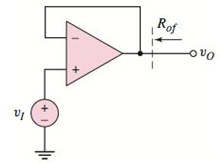
For the op−amp in the voltage follower circuit in Figure P14.14, the open−loop parameters are

Figure P14.14
Want to see the full answer?
Check out a sample textbook solution
Chapter 14 Solutions
Microelectronics: Circuit Analysis and Design
- of a Flyback converter with Circuit parameters given below.Circuit Parameters;Input Voltage Vs= 48 VN1/N2=3Lm=500 μHR=5ΩC=200 μFSwitching frequency f=40 kHzOutput Voltage Vo=10 Va) Duty Cycleb) In terms of magnetization inductor (Lm); mean, maximum andtheir minimum values;c) Find the output voltage fluctuation. (All components are ideal.assume.)arrow_forward3) Explain the construction, principle of operation, circuit and applications of Variable reluctance transducer with neat diagrams. 4) Describe the construction of LVDT and explain its principle of operation with the aid of diagram, list the advantages, disadvantages and applications of LVDT.arrow_forwardControls Systems and Automation Describing Functions Q: Describe in detail, using diagrams, how the relay tuning method is applied in practice. The describing function for a relay is given by N(a)=4M/πa. Explain each term and describe (donot derive) how this equation is developed.arrow_forward
- Hi! I need answer for questions below: Principles of operation of darlington pair DC analysis of darlington pair equation/formulas. (Applying KVL, current gain, voltage gaing etc.) AC analysis of darlington pair equation/formulas. (Applying KVL, current gain, voltage gaing etc.)arrow_forwardWhat is fractionally spaced equalizer? Discuss in detail about the function of fractionally spaced equalizer with neat diagrams.arrow_forwardQ2 (A) A frequency modulator is supplied with a carrier at frequency fc = 5 MHz and an audio tone signal of Am = 1 volt amplitude and frequency fm = 1 kHz. It produces a frequency deviation f of 10 kHz as the output of the frequency modulator. (3)(i) The FM waveform described above is passed through a frequency multiplier with a total multiplication factor of 18, that is, fout = 18*fc. After passing through the frequency multiplier, what is the frequency deviation f at the output?(ii) The output of the multiplier in part (a) is next input to a mixer stage with the LO oscillator frequency set at fLO = 55 MHz. Find the sum-frequency output fo of the mixer’s IF port and also find the magnitude of the frequency deviation f.arrow_forward
- What are Series Basic Regulators? Give an example.arrow_forwardsubject: Communication Fundamentals Modulation and Demodulationarrow_forwardSuppose a power supply is energized by an AC source of 119 V RMS. The transformer step-down ratio is 8:1, it uses a full-wave bridge rectifier circuit with silicon diodes, and the filter is nothing but a single electrolytic capacitor. Calculate the unloaded DC output voltage for this supply (assume 0.7 volts drop across each diode). Also, write an equation solving for DC output voltage (Vout), given all these parameters.arrow_forward
 Power System Analysis and Design (MindTap Course ...Electrical EngineeringISBN:9781305632134Author:J. Duncan Glover, Thomas Overbye, Mulukutla S. SarmaPublisher:Cengage Learning
Power System Analysis and Design (MindTap Course ...Electrical EngineeringISBN:9781305632134Author:J. Duncan Glover, Thomas Overbye, Mulukutla S. SarmaPublisher:Cengage Learning
